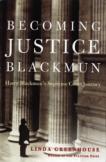One of Nine
Linda Greenhouse, the Pulitzer Prize-winning Supreme Court reporter for The New York Times, was off duty when in 1989 she joined a huge march supporting legal abortion in Washington, D.C. This was shortly before the Supreme Court heard oral arguments in a major abortion case, and other journalists criticized her participation in the march. She later told The Los Angeles Times she had been there in a totally personal, anonymous capacity with some college classmates, but that she accepted her editors’ judgment that I should not have been there.
Given her personal views, her book, Becoming Justice Blackmun, on the late Justice Harry Blackmun, author of the majority opinion in the case Roe v. Wade, is more restrained on abortion and Roe than some might expect. Drawn primarily from Blackmun’s papers at the Library of Congress, to which she was the first journalist to have access, Greenhouse’s book covers the abortion, death penalty and sex-discrimination cases and the unraveling of the nearly lifelong friendship between Blackmun and the late Chief Justice Warren Burger. (Willa Cather’s story Two Friends comes to mind heresomething broken that could so easily have been mended and something delightful that was senselessly wasted.)
Greenhouse writes well and clearly on legal issues, avoiding mind-numbing legalese. But she should have done more fact-checking on United States v. Vuitch, a 1971 case in which the Supreme Court greatly weakened abortion restrictions in the District of Columbia. Women with unwanted pregnancies were fortunate, she says, when they found their way to Dr. Milan M. Vuitch, a Serbian-born gynecologist who performed thousands of safe abortions in his Washington, D.C., clinic.
Yet a teenager died six days after an abortion performed by Vuitch in 1970. In 1974, three years after the Supreme Court legalized the activities of Vuitch and other abortionists by interpreting the health exception in the D.C. anti-abortion law to include psychological as well as physical well-being, another teenager died after an abortion by Vuitch. In 1980 the same thing happened to a 32-year-old woman. By 1984 Vuitch had botched so many abortions that a coalition of abortion supporters came out against him, and the D.C. government shut him down.
The Greenhouse account of Justice Blackmun’s role in Roe v. Wade and Doe v. Bolton, the decisions that in 1973 legalized abortion throughout the United States, is competent as far as it goes. But she underplays the radicalizing influence of Justice William J. Brennan Jr., Justice William O. Douglas and several Supreme Court law clerks. Blackmun’s initial drafts of the two opinions were far less radical than the end products. Other justices pushed him to go further, especially in protecting second-trimester abortions. Their quiet maneuvers over 30 years ago help explain why courts today keep overturning bans on the horrific practice of D&X (or partial-birth) abortion.
Harry Blackmun was a decent man, though too susceptible to pressure from senior colleagues and the spirit of the times. Greenhouse says he told one friend, soon after Roe came down, that I share your abhorrence for abortion. But his experience with the death penalty had accustomed him to separating his personal convictions from his official work. He personally opposed the death penalty, but upheld it for years on the bench because he believed the Constitution allowed it. Later, though, he concluded it was not constitutional as applied. Ironically, his opposition to capital punishment had intensified while his abhorrence for abortion had gone the other way.
Greenhouse fails to mention the key passage in Doe v. Bolton that defines health to include all factorsphysical, emotional, psychological, familial, and the woman’s agerelevant to her well-being. Roe supposedly protects abortion after fetal viability only to preserve the mother’s life or health; but the Doe definition of health means that a doctor may perform an abortion at any time for virtually any reason. Because of the failure of major media and pollsters to explain this to the American people, many Americans have no idea how radical the Roe-Doe combination really is.
As Greenhouse acknowledges, legal scholars’ early reaction to Blackmun’s Roe opinion ranged from tepid to withering. And it has remained so. Many criticsincluding abortion supporterssay Roe was an anti-democratic decision through which the court arbitrarily imposed its own policy views on the public. Some, though, complain mainly about the court’s abruptness. Had it moved slowly and waited for public opinion to catch up, they suggest, the right-to-life movement would not have become so strong and militant. Their preferred strategy: heat the water very slowly so the frogs won’t realize what is happening until they are about to become frog soup.
New York Times columnist David Brooks recently analyzed in detail how Roe has poisoned U.S. politics in a deep way. Unless the decision is overturned, he declared, politics will never get better.
Yet Roe may not be overturned unless more politicians and judges stop treating it as a sacred cow. They could start by reading abortion supporters’ criticisms of Roe. Then they should go to the heart of the matterthe way Blackmun and his colleagues ignored the humanity of the unborn. By helping women destroy their own children, they did a great injustice to both.
This article also appeared in print, under the headline “One of Nine,” in the October 17, 2005, issue.








